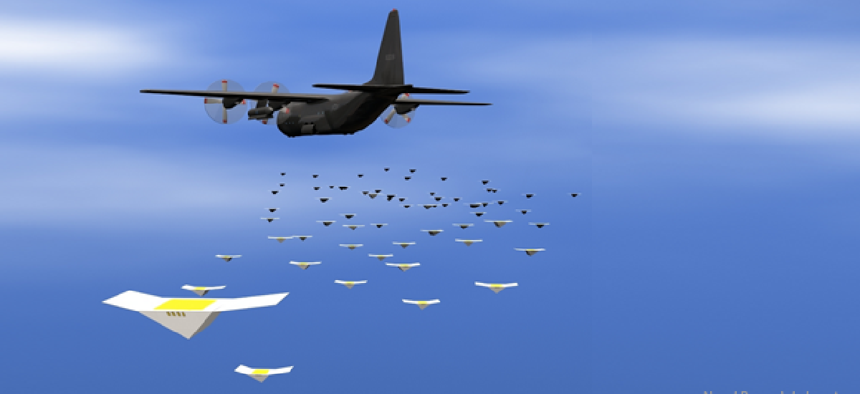Smaller drones aim to deliver squad-level intell

Researchers have begun testing micro UAVs that can give squads communications and intelligence.
Despite the continued successes of unmanned aerial vehicles, the military has expressed interest in downsizing its fleets. It's not the number of drones that will shrink, however, but rather their physical dimensions.
The Defense Advanced Research Projects Agency’s Fast Lightweight Autonomy (FLA) program seeks to give soldiers at the squad level greater intelligence with a nano UAV. About the size of a small bird, the nano UAV would fly upwards of 45 miles per hour through entrances, hallways and stairwells and relay information back to soldiers prior to entering a potentially dangerous environment. All without communicating with the operator and without GPS waypoints.
The algorithms developed for the FLA program could have a wider impact in the realm of autonomous technology by “reducing the amount of processing power, communications, and human intervention,” DARPA said in its announcement of the research program.
Researchers at the Navy Research Lab, meanwhile, have developed a nano UAV prototype called the Close-in Covert Autonomous Disposable Aircraft, or Cicada -- the insect that inspired its development. The cicada ideally will be “a low-cost, GPS-guided, micro disposable air vehicle that can be deployed in large numbers to ‘seed’ an area with miniature electronic payloads. These payloads could be interconnected to form an ad-hoc, self-configuring network. Communication nodes, sensors, or effectors can then be placed in a programmable geometric pattern in hostile territory without directly over-flying those regions or exposing human agents on the ground,” according to an NRL statement.
Described as a flying circuit board, the Cicada has no motor and consists of just10 parts. The UAV is designed to be either dropped from a manned or unmanned aircraft high above the Earth’s surface and glide to programmed GPS coordinates. The lack of motor and tiny frame (picture a paper airplane) make it undetectable in flight on enemy radars. During initial testing Cicada drones were dropped from 57,000 feet and were was able to land within 15 feet of the target area. Currently, each micro drone costs about $1,000, but NRL hopes Cicadas eventually will run around $250 apiece.
The Cicada’s mission capabilities have researchers excited about the possibilities. With various payloads such as acoustic, magnetic, chemical/biological and signals intelligence sensors, the device can relay weather conditions, monitor traffic in austere environments, detect enemy submarines using magnetic sensors or eavesdrop on adversaries. Circadas could serve as “robotic carrier pigeons,” Daniel Edwards, an aerospace engineer at the Naval Research Laboratory told Agence France-Presse. Currently, the Cicada does not support real-time video feeds because such a task requires more bandwidth than the device can support.
Other nano ISR drones can be deployed at the squad level and can hover in a static location to provide soldiers with real-time video of a particular location. Centeye, a developer of extremely compact vision systems for robotics and embedded platforms, demonstrated a UAV weighing 3 grams that features advanced sense and avoid technology and produces images and real-time feeds for situation awareness. Humans provide the height and coordinates for the hovering devices, which can also readjust for wind gusts returning to its programmed location. The technology works independently of GPS, focusing on near-earth activity as a reference point with a ceiling of 10 meters.





